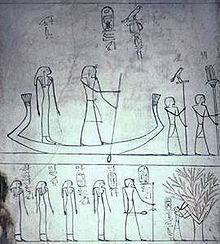Satiah
| Satiah | |
|---|---|
| Queen consort of Egypt Great Royal Wife God's Wife of Amun | |
 Queen Satiah is the second woman behind pharaoh Tuthmose III in the lower register | |
| Died | Thebes? |
| Burial | Thebes? |
| Spouse | Thutmose III |
| Issue | Amenemhat (disputed[1]) |
| Dynasty | 18th Dynasty |
| Mother | Ipu, a royal nurse |
| Religion | Ancient Egyptian religion |
Satiah (also, Sitiah, Sitioh; "Daughter of the Moon") was an ancient Egyptian queen, the first Great Royal Wife of Pharaoh Thutmose III.[2]
Family
| ||||||||||
| Satiah in hieroglyphs | ||||||||||
|---|---|---|---|---|---|---|---|---|---|---|
| Era: New Kingdom (1550–1069 BC) | ||||||||||
Satiah was the daughter of the royal nurse Ipu.[3] It is possible that her father was the important official Ahmose Pen-Nekhebet.[4] Most probrably she was the mother of Prince Amenemhat – Thutmose's eldest son (sometimes considered son of Neferure), who died during his father's reign.[5]
Satiah died during her husband's reign, shortly after Hatshepsut's death, and Thutmose's next Great Royal Wife was Merytre.
Biography
Satiah's titles include: King's Wife (ḥmt-nisw), Great King's Wife (ḥmt-niswt-wrt) and God's Wife (ḥmt-ntr).[6]
Satiah is attested in several places. In Abydos the text on an offering table mentions her mother, the “nurse of the god” Ipu. The offering table was dedicated by the lector priest Therikiti.[7] A bronze votive axe-head(?) (now in the Cairo Museum), inscribed with the name of Queen Satiah, was also found in Abydos.[8]
At the temple of Montu at El-Tod a statue of the queen was dedicated by Tuthmose III after her death (the statue is now in the Cairo Museum).[9]
Queen Satiahis depicted behind Queen Merytre-Hatshepsut and Thutmose III on a pillar in the tomb of the king (KV34). Behind Queen Satiah we see the King's Wife Nebtu and the King's Daughter Nefertari.[10]
Satiah is depicted before Tuthmose III in a relief from Karnak.[11] A stela in the Cairo Museum shows Queen Satiah standing behind Tuthmose III.[12]
References
- ^ Sometimes he is considereted son of Neferure.
- ^ Aidan Dodson; Dyan Hilton (2004). The Complete Royal Families of Ancient Egypt. Thames & Hudson. p. 140. ISBN 0-500-05128-3.
- ^ Dodson & Hilton, p.140
- ^ "Anneke Bart: The New Kingdom Tombs of El Kab / Nekhen". Archived from the original on 2007-10-12. Retrieved 2007-04-27.
- ^ Dodson & Hilton, pp. 132–133, 137, 140
- ^ Grajetski Ancient Egyptian Queens: a hieroglyphic dictionary Golden House Publications. p.53
- ^ Porter and Moss Topographical Bibliography; Volume V Upper Egypt Griffith Institute. p.52
- ^ Porter and Moss Topographical Bibliography; Volume V Upper Egypt Griffith Institute. p.49
- ^ Porter and Moss Topographical Bibliography; Volume V Upper Egypt Griffith Institute. p.169
- ^ A. Bart Queen Sitiah website [1]
- ^ A. Bart Queen Sitiah website [2]
- ^ A. Bart Queen Sitiah website[3]
Further reading
Alexandre Herrero Pardo, Satiah, 1ª Gran Esposa Real; Meritre, 2ª Gran Esposa Real; Isis, la madre del Rey - Las mujeres en la vida de Tutmosis III - Los Nobles de Egipto
External links
- Queen Sitiah (website by A. Bart)
- v
- t
- e
| |||||||||||||||||||||
| |||||||||||||||||||||
| |||||||||||||||||
| |||||||||||||||||||
Dynastic genealogies | |
|---|---|
|












